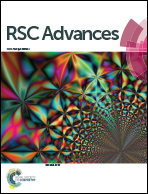CTAB@BiOCl: a highly adsorptive photocatalyst for eliminating dye contamination†
Abstract
The title composite was synthesized under facile conditions by hydrolysis and co-precipitation. Through comparative studies, it was found that the morphology, structure and properties were affected by hexadecyl trimethylammonium bromide (CTAB) doping. Although the surface area decreases from 53.5 to 7.5 m2 g−1, it was found that CTAB@BiOCl exhibits higher adsorption capacity than the isolated BiOCl, and still maintains good photocatalytic activity, which is a little worse than the isolated BiOCl has. This was caused by the lower content of BiOCl in CTAB@BiOCl, which is less than 70%. The studies show that, in high concentrations of dye-contaminated water, the composite exhibits strong adsorption capacities of 901 mg g−1 to Congo Red (CR) and 699 mg g−1 to Reactive Red 3 (X3B). In the low-concentration case, it is able to process photocatalysis of those dyes. In the recycling experiment, the CTAB@BiOCl composite was regenerated in situ. And CTAB in the composite was almost completely degraded after five cycles, resulting in the regenerated BiOCl. Subsequently, the surface area of the composite increases from 7.5 to 22.62 m2 g−1, and along with this the adsorption capacities to CR and X3B decrease obviously due to the absence of the CTAB component. In addition, the photocatalysis activity of the generated composite has been promoted to be similar to the isolated BiOCl.


 Please wait while we load your content...
Please wait while we load your content...